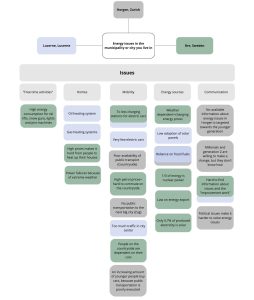
Based on a 2-minute podcast in which each team member shared their thoughts on energy issues in the community or city where they live, we created a map of all the issues we identified in each podcast. Here are some of the key insights we gained from analyzing Åre (SWE), Lucerne (CH), and Horgen (CH):
Lucerne has plans to become a more sustainable city in terms of transport, energy consumption, and energy generation. Regarding mobility, Lucerne currently has only a few electric vehicles, the large majority of cars are powered by petrol and diesel. By 2040 all the cars driving in the city should be electric or powered by another renewable energy source. Furthermore, the overall car traffic should be reduced by 15%.
When it comes to homes, the vast majority of households are still heated with oil or gas systems. Currently, this results in per capita greenhouse gas emissions of around 5,1 tonnes per year. The city aims to reduce this number to 0 by 2040 meaning no more oil and gas heating systems.
For energy generation, the city wants to increase its solar energy generation. At the moment from solar panels makeup 2% of the yearly electricity generation, by 2050 it should be 25%.
Horgen is committed to the efficient use of energy, climate protection, renewable energies, as well as environmentally-friendly mobility and is even certified as an energy city with gold status.
The availability of buses in the countryside is very poor, however, since buses only arrive every hour. This results in more people purchasing a car to be more flexible.
During the research, it became also clear that the younger generation is very little involved by the community. This is a pity, as movements like „Fridays for Future“ prove that millennials and Generation Z are very interested in making a difference. This is an opportunity that is not being taken by the municipality.
In general, Åre is good at using renewable energy sources like wind, water, and sun. The biggest supply company for electricity is “Jämtkraft” and they are only offering their customers 100% renewable energy from wind, water, sun, and also by bio-energy.
The three main issues in Åre are 1. the increased price of electricity. Which is caused by different factors such as the weather and temperature, supply and demand, and also the increased oil and gas prices. Normally, the electricity price in Sweden is quite low, so when it increased by almost 400% in December, people got a chock and had a hard time paying the bills to heat up their houses.
2. The high amount of electricity which is consumed in Åre. It’s because of the big ski area which needs to run over 40 lifts, produce snow, light up the slopes and also make the conditions good with piste machines. Skiing requires a lot of energy, but Åre is doing a good job in using renewable energy sources to power the ski area and also using HVO 100 to power the machines.
3. The mobility in the countryside. Including the lack of charging stations for electric cars. As it looks today, people can’t really take their electric car to Åre because there are not enough power stations to charge. The people in the countryside are also dependent on their cars since the infrastructure is not sufficient enough to get from A to B in a convenient way. The increased prices on petrol as Diesel is also a chock for the people in Åre. Since they are dependent on their car it’s a challenge to afford all these price increases for electricity and petrol.
/ Lin Ivarsson, Lisa Kraan and Cyril Forster
